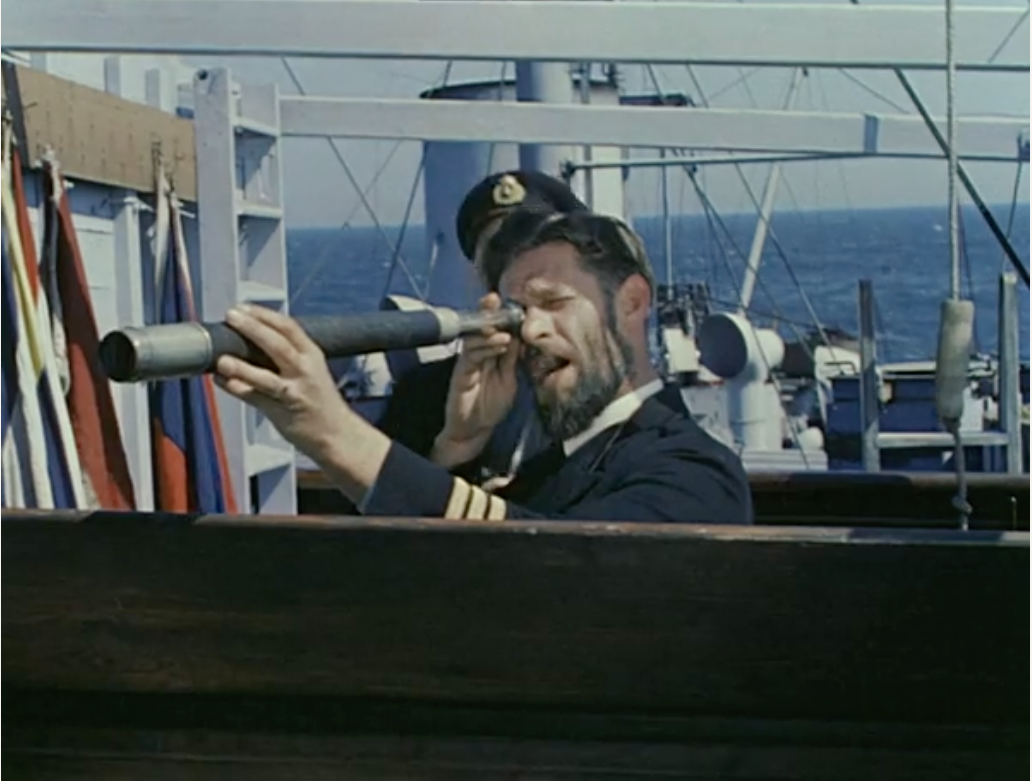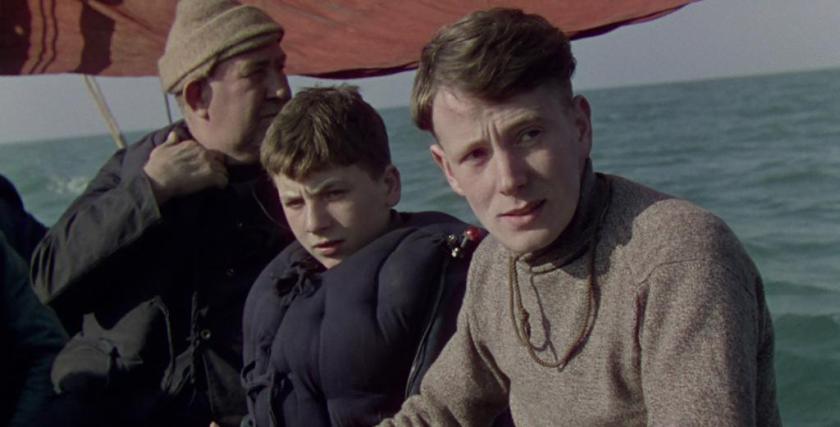Writer-director Pat Jackson’s Western Approaches (1944), a Technicolor tour de force partly shot in turbulent seas by Jack Cardiff, is a stirring World War II story documentary that demonstrates the bravery, resilience, selflessness, and collective spirit of men of the British Merchant Navy during the Battle of the Atlantic.
The merchantman Jason having been torpedoed by a U-boat, its 22 survivors (including one seriously wounded) struggles towards Ireland’s west coast – 18 days away if the rate of 60 miles in 24 hours is maintained, though neither its rations nor its radio will hold out that long.
The crewmen sing, banter about wives and pubs, and bicker mildly as the craft fights ferocious waves. Simultaneously, tanks, locos, and aircraft are loaded onto merchant ships in New York Harbour and a conference of Allied officers discuss the naval and air protection that's being provided for the convoy.
At night, the men in the lifeboat hear the diesel engine of a U-boat that has surfaced to change its batteries. With one ship ailing, the convoy slows to four knots, but the lead vessel Leander can’t keep station at that speed and moves ahead. Picking up the lifeboat’s signal, it shears off course to rescue its crew, becoming a target for a U-boat stalking the lifeboat in hopes of making a bigger kill. Heroically, the lifeboat crew tries to divert Leander.
 An averted mutiny on the lifeboat aside, the film’s middle act has a flat business-as-usual quality, so determined was Jackson to show the imperturbability of imperilled British sailors – bearded, pipe-smoking upper-class officers and rough-hewn able seamen alike. But as the U-boat’s excited skipper gets Leander in his periscope’s crosshairs, Western Approaches becomes gripping.
An averted mutiny on the lifeboat aside, the film’s middle act has a flat business-as-usual quality, so determined was Jackson to show the imperturbability of imperilled British sailors – bearded, pipe-smoking upper-class officers and rough-hewn able seamen alike. But as the U-boat’s excited skipper gets Leander in his periscope’s crosshairs, Western Approaches becomes gripping.
Jackson had joined the GPO Film Unit as a messenger boy on his seventeenth birthday in 1935. As a production assistant on Night Mail (1936), directed by his mentor Harry Watt and Basil Wright, he helped solve one of its sound problems by running a model Bassett-Lowke loco over its toy track. He went onto direct The Horsey Mail (1938), set in the flooded eponymous Norfolk village, and, following the outbreak of war, joined Watt and Humphrey Jennings in shooting scenes for The First Days (1939), produced by Alberto Cavalcanti.
With the GPO Film Unit absorbed into the Crown Film Unit along with other independent documentary groups under the Ministry of Information, Watt and Jennings began using dramatic techniques and visual poetry to enrich their non-fiction propaganda films, the American audience and its isolationist government always in mind. If this approach conflicted with John Grierson’s belief that documentaries should educate rather than entertain, it made for compelling cinema.
Depicting the planning and execution of a raid on a German oil storage facility in Freiburg and focusing on the crew of a Wellington bomber, Watt's Target for Tonight (1941), which featured RAF personnel doing their jobs, set a standard. The MOI already had J.B. Holmes's Merchant Seamen (1941) and Coastal Command (1942) in production when the Admiralty offered its full support on a Technicolor film. The aim was to boost the morale of the Merchant Navy by showing how the Royal Navy protected its ships, which were suffering appalling losses (over 16 per cent of the Merchant Navy’s 185,000 wartime seamen were killed).
In the event, the CFU production that became Western Approaches emphasized the endurance of the merchant seamen and the harmony and cooperation among the officers and crews of their ships. According to the illuminating introductory essay written by the Imperial War Museum’s Toby Haggith for the BFI's Western Approaches dual-format disc, Jackson said the Sea Lords were irked by “the Royal Navy being displaced by the Royal Navy” in the film.
The non-professional cast was drawn from the Allied navies and merchant fleets, primarly men found at the Shipping Federation Offices and nearby Angel pub in Liverpool. (Two silent members of the Women’s Auxiliary Air Force appear fleetingly at the Western Approaches command centre in Liverpool’s Derby House.) Haggith reports that Jackson assembled a group of men, including weatherbeaten tars, who looked right for their roles and had experienced incidents like those the film would show.
According to production manager Dora Wright, writes Haggith, “the actors were ‘little trouble’, and gave good performances ‘when sober’, but drink and the unaccustomed demands and monotony of screen acting meant it was difficult to rely on the cast day after day.” The scenes in the lifeboat took six months to film in the Irish Sea, some no more than 500 yards from Holyhead's harbour in Anglesey.
 The era’s political sensitivities explain why the casting erred in omitting Empire and other foreign sailors who served with the Merchant Navy during the war. Despite Jackson’s misgivings that the actors were unable to develop their individuated characters consistently, the performances are solid – except in occasional moments where expository dialogue was required. The U-boat captain and his men, whose exchanges in German are subtitled, come across as calm and efficient as the Brits.
The era’s political sensitivities explain why the casting erred in omitting Empire and other foreign sailors who served with the Merchant Navy during the war. Despite Jackson’s misgivings that the actors were unable to develop their individuated characters consistently, the performances are solid – except in occasional moments where expository dialogue was required. The U-boat captain and his men, whose exchanges in German are subtitled, come across as calm and efficient as the Brits.
The convoy scenes were maximised for authenticity (and economy), being filmed during a six-week round trip in the summer of 1943. On 14 August, the ship in front of the filmmakers' vessel was torpedoed and set on fire; Jackson said three of the convoy’s ships were eventually sunk by U-boats. No less than the men they were filming, Jackson's crew was on active duty.
The BFI’s booklet for the home-video release is one of its best. Haggith and fellow essayist Martin Stollery detail the problems faced by Cardiff in filming with the three-strip Technicolor process and the newly devised Monopack system (which used special 35mm Kodachrome stock) used on location; there are further articles on Jackson, Cardiff, Clifton Parker’s sparingly used score, and the film’s restoration.
Features include the 2004 commentary recorded by Jackson and Haggith for the 2004 DVD; Craig McCall’s 1999 “making of” short Colour on Sea featuring Jackson and Cardiff; Jackson’s Ferry Pilot (1941) and Builders (1942), Jack Ellitt and Basil Wright’s This Is Colour (1942), a documentary on Technicolor cinematography and theory showcasing Cardiff’s wizardry; and John Taylor’s People at War – A Seaman’s Story (1943). There's also Ronald Riley’s industrial process documentary Steel (1945), its blistering metallic imagery another of Cardiff's Technicolor triumphs.















Add comment